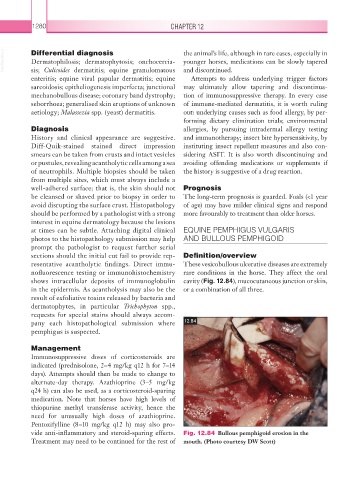Page 1305 - Equine Clinical Medicine, Surgery and Reproduction, 2nd Edition
P. 1305
1280 CHAPTER 12
VetBooks.ir Differential diagnosis the animal’s life, although in rare cases, especially in
younger horses, medications can be slowly tapered
Dermatophilosis; dermatophytosis; onchocercia-
sis; Culicoides dermatitis; equine granulomatous
Attempts to address underlying trigger factors
enteritis; equine viral papular dermatitis; equine and discontinued.
sarcoidosis; epitheliogenesis imperfecta; junctional may ultimately allow tapering and discontinua-
mechanobullous disease; coronary band dystrophy; tion of immunosuppressive therapy. In every case
seborrhoea; generalised skin eruptions of unknown of immune-mediated dermatitis, it is worth ruling
aetiology; Malassezia spp. (yeast) dermatitis. out: underlying causes such as food allergy, by per-
forming dietary elimination trials; environmental
Diagnosis allergies, by pursuing intradermal allergy testing
History and clinical appearance are suggestive. and immunotherapy; insect bite hypersensitivity, by
Diff-Quik-stained stained direct impression instituting insect repellent measures and also con-
smears can be taken from crusts and intact vesicles sidering ASIT. It is also worth discontinuing and
or pustules, revealing acantholytic cells among a sea avoiding offending medications or supplements if
of neutrophils. Multiple biopsies should be taken the history is suggestive of a drug reaction.
from multiple sites, which must always include a
well-adhered surface; that is, the skin should not Prognosis
be cleansed or shaved prior to biopsy in order to The long-term prognosis is guarded. Foals (<1 year
avoid disrupting the surface crust. Histopathology of age) may have milder clinical signs and respond
should be performed by a pathologist with a strong more favourably to treatment than older horses.
interest in equine dermatology because the lesions
at times can be subtle. Attaching digital clinical EQUINE PEMPHIGUS VULGARIS
photos to the histopathology submission may help AND BULLOUS PEMPHIGOID
prompt the pathologist to request further serial
sections should the initial cut fail to provide rep- Definition/overview
resentative acantholytic findings. Direct immu- These vesicobullous ulcerative diseases are extremely
nofluorescence testing or immunohistochemistry rare conditions in the horse. They affect the oral
shows intracellular deposits of immunoglobulin cavity (Fig. 12.84), mucocutaneous junction or skin,
in the epidermis. As acantholysis may also be the or a combination of all three.
result of exfoliative toxins released by bacteria and
dermatophytes, in particular Trichophyton spp.,
requests for special stains should always accom-
pany each histopathological submission where 12.84
pemphigus is suspected.
Management
Immunosuppressive doses of corticosteroids are
indicated (prednisolone, 2–4 mg/kg q12 h for 7–14
days). Attempts should then be made to change to
alternate-day therapy. Azathioprine (3–5 mg/kg
q24 h) can also be used, as a corticosteroid- sparing
medication. Note that horses have high levels of
thiopurine methyl transferase activity, hence the
need for unusually high doses of azathioprine.
Pentoxifylline (8–10 mg/kg q12 h) may also pro-
vide anti- inflammatory and steroid-sparing effects. Fig. 12.84 Bullous pemphigoid erosion in the
Treatment may need to be continued for the rest of mouth. (Photo courtesy DW Scott)

